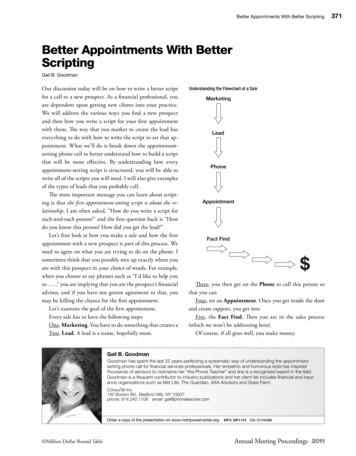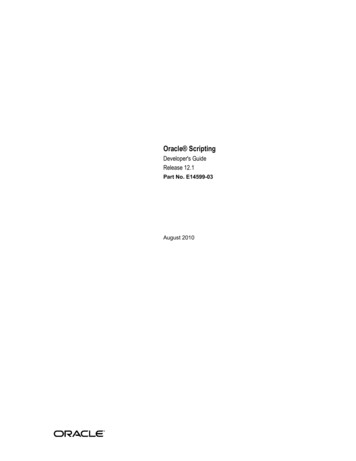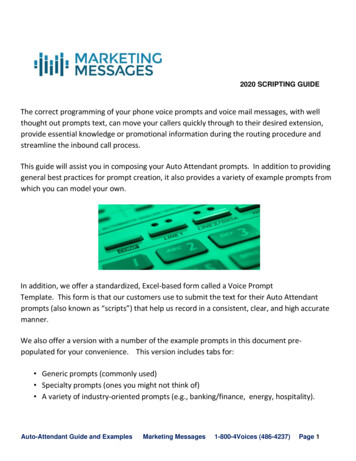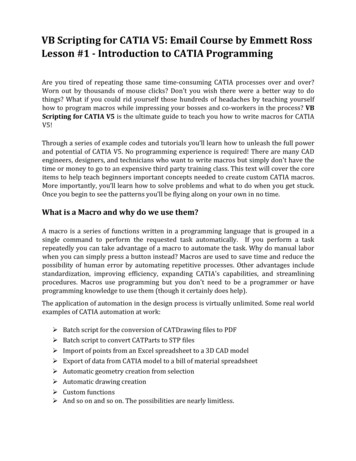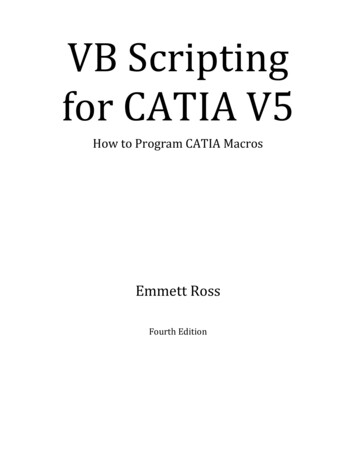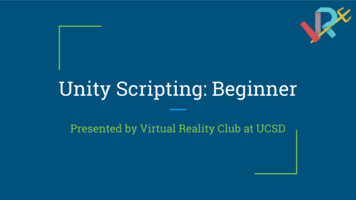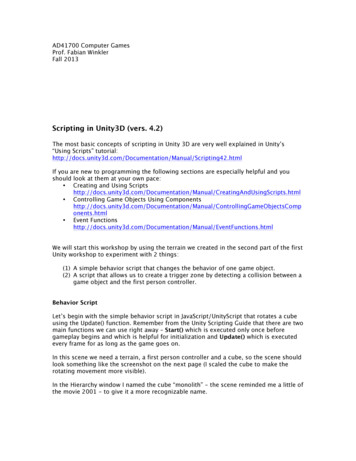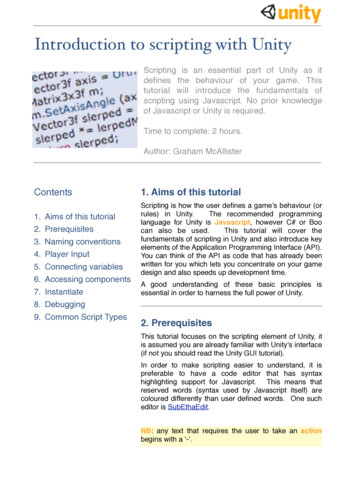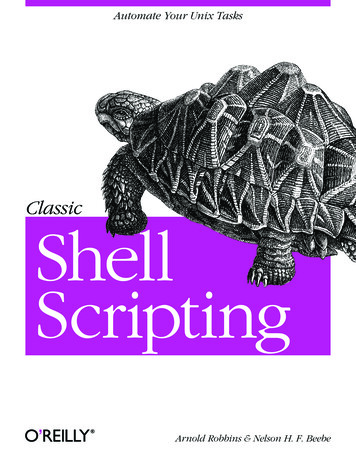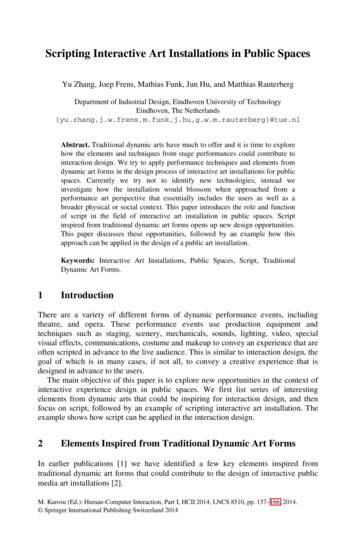
Transcription
Scripting Interactive Art Installations in Public SpacesYu Zhang, Joep Frens, Mathias Funk, Jun Hu, and Matthias RauterbergDepartment of Industrial Design, Eindhoven University of TechnologyEindhoven, The auterberg}@tue.nlAbstract. Traditional dynamic arts have much to offer and it is time to explorehow the elements and techniques from stage performances could contribute tointeraction design. We try to apply performance techniques and elements fromdynamic art forms in the design process of interactive art installations for publicspaces. Currently we try not to identify new technologies; instead weinvestigate how the installation would blossom when approached from aperformance art perspective that essentially includes the users as well as abroader physical or social context. This paper introduces the role and functionof script in the field of interactive art installation in public spaces. Scriptinspired from traditional dynamic art forms opens up new design opportunities.This paper discusses these opportunities, followed by an example how thisapproach can be applied in the design of a public art installation.Keywords: Interactive Art Installations, Public Spaces, Script, TraditionalDynamic Art Forms.1IntroductionThere are a variety of different forms of dynamic performance events, includingtheatre, and opera. These performance events use production equipment andtechniques such as staging, scenery, mechanicals, sounds, lighting, video, specialvisual effects, communications, costume and makeup to convey an experience that areoften scripted in advance to the live audience. This is similar to interaction design, thegoal of which is in many cases, if not all, to convey a creative experience that isdesigned in advance to the users.The main objective of this paper is to explore new opportunities in the context ofinteractive experience design in public spaces. We first list series of interestingelements from dynamic arts that could be inspiring for interaction design, and thenfocus on script, followed by an example of scripting interactive art installation. Theexample shows how script can be applied in the interaction design.2Elements Inspired from Traditional Dynamic Art FormsIn earlier publications [1] we have identified a few key elements inspired fromtraditional dynamic art forms that could contribute to the design of interactive publicmedia art installations [2].M. Kurosu (Ed.): Human-Computer Interaction, Part I, HCII 2014, LNCS 8510, pp. 157–166, 2014. Springer International Publishing Switzerland 2014
1582.1Y. Zhang et al.StagecraftStagecraft in traditional dynamic arts includes lighting (e.g. different lighting effectsused to change or enhance mood), costumes, makeup (e.g. in Beijing Opera, differentcolors of facial makeup identify different personalities of roles), props, stagemanagement (e.g. on the stage how to set the positions of props and actors) andrecording and mixing of sound. However, in the actual interactive process there mightnot be any clear boundary between stage space and audience space. The space couldinclude the spread of stage and the combination installation itself and itssurroundings, as well as the participants. For the interactive public media arts,stagecraft is reflected by not only arrangement on the installation itself, but alsomanagement about whole environment and all possible participants. In interactivedesign, stagecraft is added technological elements, for instance designers use newmultimedia tool, like photographs, video, or projector to make media art installations.2.2Different Roles in Performance Arts: Operators, Performers andSpectatorsThe participant of an interactive public art installation is more than a passive user. Forexample, participation comes to an interactive experience happened in public spaces,is about: what one does is experienced by someone else, and that the others are seeingand experiencing that one is experiencing something[3]. One of ways of participatingin creating and interacting[4] with a public art installation is to transform roles amongoperator, performer, and spectator at designated or preferred time [1]. On manyoccasions, participants are both operating and performing, and also are spectators. Onsome occasions, operators (designers or artists) could be performers.2.3Different Attention Spaces: Foreground, Mid-ground and BackgroundGetting the attention of the public is usually a challenging task especially when the artinstallation is in an open space, surrounded by buildings, lights, plants and busypeople. Dividing the space of the interactive public art installation into foreground,mid-ground and background could help get attention from people in randomsurroundings [1].2.4Front Stage and Back Stage in Time and in SpaceEvery public space could be seen as a stage. We defined the space of interactive artinstallation which is on front stage and other invisible components on back stage (likeorganization, supervision, mechanical devices, managers, etc.) When a participant onthe front stage, she does not know what happened, is happening or will happen on thebackstage. Sometimes interactive designers deliberately blur the difference betweenthese two stages. That’s sometimes why we can see mechanical devices be moved tothe interactive space and opened to the public. On this kind of occasions, the metalevel of the “making” also plays a role, and this might even deliver a completely newexperience.
Scripting Interactive Art Installations in Public Spaces159Talking about interaction design in public spaces, what is possible in a givenenvironment? “It can be an experience of two folds: the first is the stimulation toimagination and emotion that is created by carefully crafted uncertainty. The secondis the satisfaction provided by closure when the play is completed, if the plot has beensuccessfully constructed. The experience unfolds over time” [1].Next, based on these elements learned from traditional dynamic arts, we also findhow to script well above-mentioned elements and how to make a “script” in theprocess of designing installation could shape the user’s experience.3Scripting Interactive Art Installations in Public Spaces3.1Script and ScenarioIf we look through passing thousand years of history of traditional dynamic arts, likedrama, script is the base of traditional dynamic arts, which mainly composed of linesand stage directions. Scripts use dialogue, monologue, narrations or librettos as firstperson narrators to represent the development of stories. Furthermore, in drama, thestage directions in the script are a kind of narrative text which is based on the tone ofthe writers. These directions include the story of the time and the place, thearrangement of image characteristics, body movements and activities in the realscene, description of the atmosphere, as well as the stagecraft and other requirements.In the history of drama, the script appears roughly officially formed and maturedrama. For script writing, the most important aim is to be performed on the stage, notjust as literature text. It could become only half finished until after the stageperformances (e.g. "show text") is the ultimate artistic rendering. Yet the actors canperform on stage based on the original script, with necessary changes or modificationsaccording to every different stage, and different understanding of the actorsthemselves as well. Therefore, script has an important function that allowsmodification, and during the process these modifications would produce detailedannotation, and mark a passage in the script how to work with the real show script.A script often falls into a theme. The most common contemporary understandingof the theme for a script is an idea or concept that is central to a story, which can oftenbe summarized in the “path of life” [5] (e.g. for “birth”, for “communion”, and for“passing on”). “In all religions and cultures there was this understanding that lifehappens in distinctive eras with each a specific content, that there are thresholds thatgive entrance to it and that it is important to cross them consciously and with the righteffort. When the time was right the community prepared together with that person,symbolized the transition to procure conscious life.” [5] An example of this would bein Harry Potter film series. The theme of script for Harry Potter and thePhilosopher’s Stone is death while Harry Potter and the Goblet of Fire is prejudice.Every show-work always has a theme even when it is just a script. Motif andexpression are two parts for one script, including “What the work says about thesubject” and “what the audiences think the work is about”. One of these two parts cansometimes overwhelm the other one depending on interpretation and performance.
160Y. Zhang et al.Scenario is a close concept to script which is the description of one piece or onepossibility of series of actions and events depending on the story context. It is used indifferent kinds of areas (like military, politics, design). A scenario is often developedinitially to indicate how the original source, if any, is to be adapted and to summarizethe aspects of character that can be expanded later. To some extent, scenario could belook as the outline of scripts.In interaction design, an interaction scenario is “a fully specified design vision: theusers and task(s) being supported, the information needed to carry out the task,the actions the users take to interact with the task information, and the responses thesystem provided to users actions” [6]. Scenarios often play an important role in theprocess of concretization of a design concept by specifying a story to construct andillustrate the design concept or design solution [7]. Scenarios may be related to usecases and help focus design efforts on the user’s requirements. Scenarios can beunderstood by people who do not have any technical background. They are thereforesuitable for being used during participatory design activities.Nevertheless scenario planning has several notable limitations [8]:“1: One criticism of scenario commonly used is that resulting results insomewhat arbitrary scenario themes.2: Apart from some inherent subjectivity in scenario design, the techniquecan suffer from various process and content traps.3: A third limitation of scenario planning in organizational settings is itsweak integration into other planning and forecasting techniques.”According to the comparison, we can find that scripting interactive art installationsin public spaces can make up for the limitations of scenario. That’s the reason for usto introduce script instead of scenario in designing interactive art installations inpublic spaces. Designers sometimes need to predict all possibilities before the designprocess and confront with traps during the design process, at this point, script couldhelp designers push concepts much deeper and make the concepts to be fulfilled ascloser as their purpose. This kind of sketching technique can be helpful in pitching theidea to a prospective producer, director or composer.3.2Script in Traditional Dynamic Art FormsIn traditional dynamic arts, script is the instructions for actors to perform a play. Itincludes the lines each of the actors must say, some indications of stage actions (alsocalled stage directions) and the description of surroundings. While script fortraditional dynamic arts specifies normal lines or stage directions, interpretation andperformance techniques can vary. How to attract attention is one part of script. Inancient time for both eastern opera and western drama, theatrical performance alwaystook place in a noisy and crowded open and public space with a rudimentary stage,
Scripting Interactive Art Installations in Public Spaces161which is different from the situation nowadays in quiet and well organized theaters.Ancient troupes also found effective approaches to attract audiences and you also canfind this kind of instructions in the script. They would repeatedly remind the audienceof the happened plot in latter scenes. An actor would wear a plate with the name ofthe character, so that the audience could easily find the character relationship at anygiven time. Also, at the beginning, they would use the long lines to introduce thedevelopment of whole story. A unique technique often used in Beijing Opera is that,before the opening, the protagonist would always sing shortly on the back stagebefore appearing on the front stage, to prepare the audience, raise the expectation andset the mood. In traditional dynamic arts, these aforementioned performancetechniques are one important part of script, which also is the main reason for us tointroduce script to design of interactive art installation3.3How to Transform Script into Interactive Art Installations in PublicSpacesWe have tried to apply performance techniques and elements from dynamic art formsin the design process of interactive art installations for public spaces [1]. As a stageplay needs a script, do we also need a script when we design an interactive artinstallation for a public space? What is the role and function of such a script in thedesign process and in the designed installation? And how much space we shall leavein the script for the interpretation and performance?3.4Opportunities and ChallengesFor interactive art installations in public spaces, we are facing the same problem ofnoisy environments and often crowed audience. Scripting interactive art installationcan be a possible solution to tell participants something will happen or somethingalready happened to the audience that joins and leaves at any time. To a certainextent, script helps extend the time. Extending the time here, not just extending thetime for interaction process, also about extending the time for expectation and timefor traces after interaction. For a dynamic audience, we would also expectthe scripting, interpretation and per
how to script well above-mentioned elements and how to make a “script” in the process of designing installation could shape the user’s experience. 3 Scripting Interactive Art Installations in Public Spaces 3.1 Script and Scenario If we look through passing thousand years of history of traditional dynamic arts, like drama, script is the base of traditional dynamic arts, which mainly .



